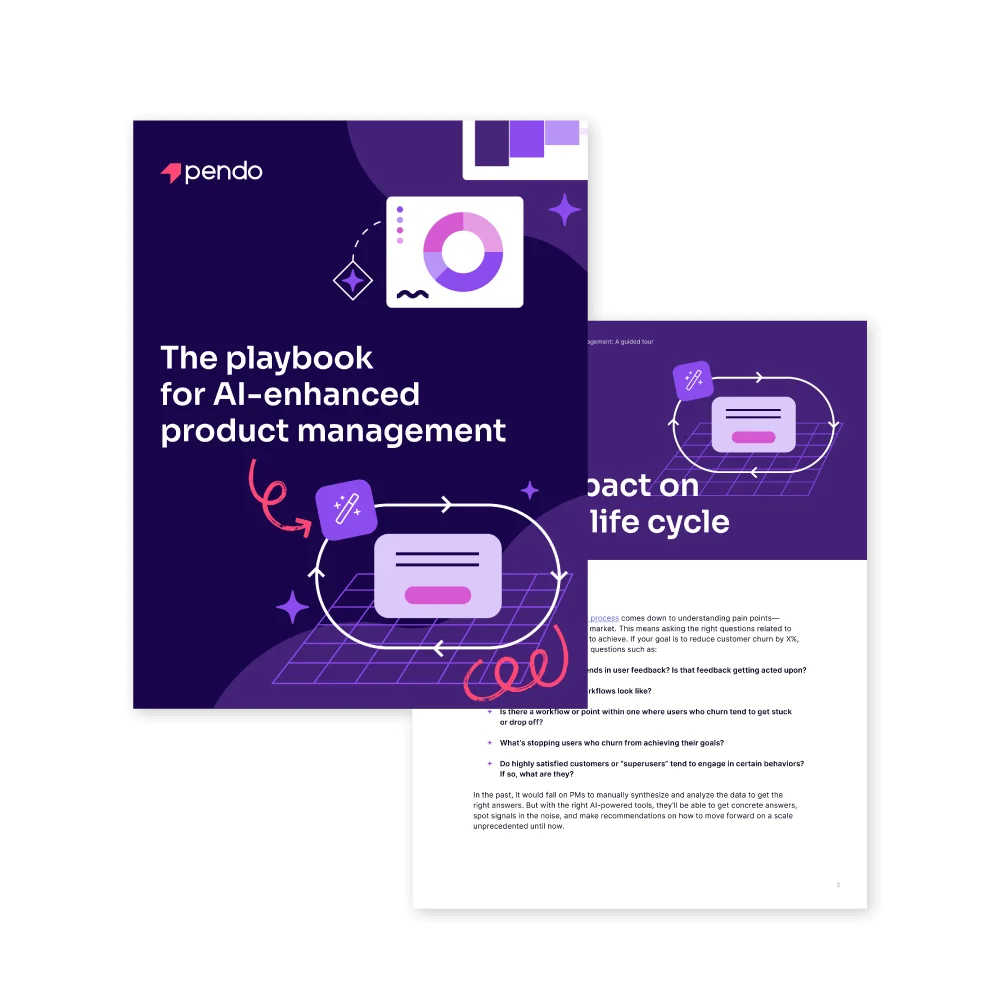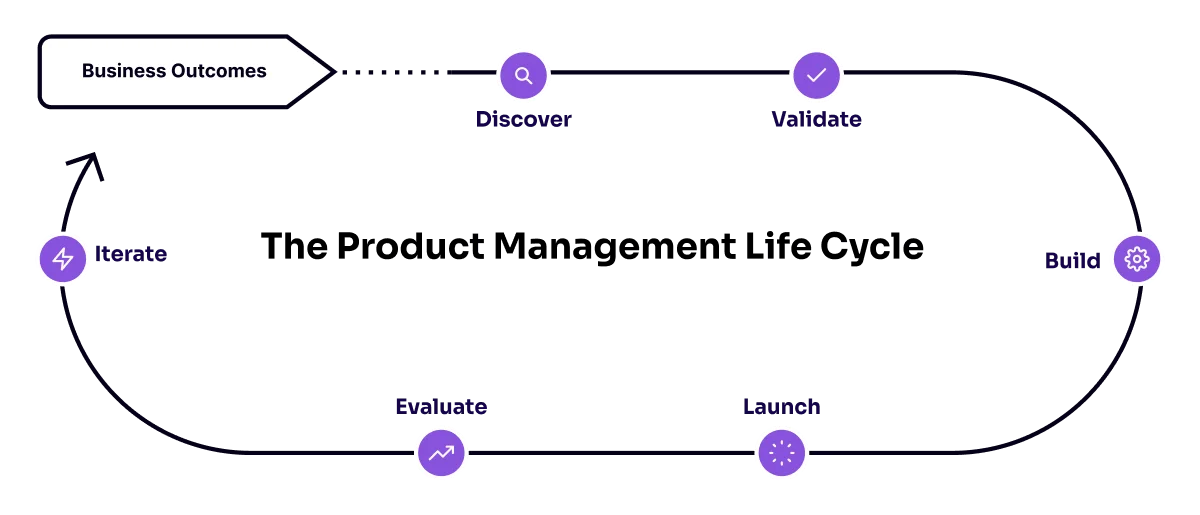
目次
In a rush? Download the PDF for later
Download the 電子書籍はじめに
ビジネスをより強固なものにすることを目指すクリエイターとして、プロダクトマネージャー(PM)は常に、より多くのことをよりうまく遂行する方法を模索しています。PM向けのプロダクトは毎週のようにリリースされますが、そのどれもが現状を根本から変えられると謳っています。このような状況下では、そのテクノロジーが実際の業務にどれほど役に立つのかとPMが疑いたくなるのも無理はありません。人々の注目を浴びるアプリやツールは毎月のように登場しますが、そのほとんどは結局のところ、誇大広告によって一時的に注目を集めただけに過ぎません。
When AI exploded onto the business scene, however, something was different. The launch of ChatGPT and other large language model (LLM) platforms didn’t feel like empty hype, and there was a reason for this. According to a recent McKinsey report, the broad utility of generative AI can create value across a wide array of business use cases. In macro, they estimate GenAI will add between $2.6 and $4.4 trillion per year to the global economy. Every business function will feel the impact in unique ways. That includes product managers, for whom this transformative tech will be particularly empowering.
役割の変革
Even before AI took the business world by storm, the role of a product manager (PM) was changing. What was once a niche, engineering-adjacent position limited to shipping product and feature updates has evolved into a holistic function critical to business health. In the face of an economic downturn, business leaders are turning to PMs and the tools they use to drive better outcomes—including higher growth, lower churn, and reined-in costs.
“Product management is to be like an evolving sport. It is getting transformed yet again in the wake of AI,” notes Mayukh Bhaowal, director of product management at Salesforce Einstein. Product teams are now wondering how their lives and work will evolve in the age of artificial intelligence. With the impact of this transformative technology only beginning to be felt across the business world, no part of the product management voyage will be left untouched. Throughout each stage of product development, PMs will be able to embrace AI as a partner and execute like never before.
What will this transformation look like? In this guide, we’ll consider that question through the lens of the product-management lifecycle, a framework for conceptualizing, building, launching, and iterating on software products in order to achieve a desired strategic or business outcome. While the specifics of the AI tools in question continue to evolve by the day, we’re beginning to understand the general impact they’ll have on the increasingly business-critical work PMs do.
フェーズ1:発見
For PMs, a successful discovery process comes down to understanding pain points—both of users and of the greater market. This means asking the right questions related to the business outcome you want to achieve. If your goal is to reduce customer churn by X%, for example, you might consider questions such as:
- ユーザーからのフィードバックにはどのような傾向があるか。そのフィードバックには対処しているか。
- ユーザーの一般的なワークフローはどのようになっているか。
- 解約したユーザーには、特定のワークフローやポイントで行き詰まったり離脱したりする傾向があるか。
- 解約したユーザーの目標到達の妨げになっていたのは何か。
- 満足度の高い顧客や「スーパーユーザー」には特定の行動をとる傾向があるか。ある場合、それはどのような行動か。
以前は、PM自身がデータを手動で組み合わせて分析し、これらの問いに対する正しい答えを導き出そうとしていました。しかし、AIを活用した適切なツールがあれば、PMは明確な答えを得られ、ノイズの中から兆候を特定し、かつてない規模で前進するための方法を提案できるようになります。
AIが現状を変える方法
PMは、カスタマーサポートやユーザーへのインタビュー、NPS、フィードバック、営業やサポートへの問い合わせ、プロダクトの使用状況、その他のソースから得たデータをより上手く統合できるようになります。AIツールは、複数のデータソースからパターンを特定することで、PMの貴重な時間を節約します。
The analysis these tools will produce will come with actionable recommendations and evidence to justify the proposed investment(s). This will make the discovery phase exponentially quicker, and the PM coming out of it more confident in their findings.

第2段階:検証
発見の段階で特定された問題点や課題には、有効なソリューションが常に複数存在します。これらのソリューションのうち、「顧客の満足度とビジネスのROIの両方を最大化する」という最高の結果をもたらす可能性が最も高いものはどれでしょうか。ここで、検証の段階が始まります。AIを活用することで、PMはかつてない方法で、自信を持って開発内容を決定できるようになります。
従来の検証段階は時間がかかるうえに扱いにくく、この段階を飛ばしたり、簡単に済ませたりしようとするPMも多く、この点がプロダクトの開発を見誤るリスクになっていました。というのも、過去の検証プロセスには、顧客へのインタビューを手動で設定し、課題に対するソリューションを顧客に提示し、そこからフィードバックや回答を得るという作業が伴っていたからです。最近では、プロダクトの使用状況データ、アプリ内の投票とアンケート調査、サポートチケットによるリクエストなど、PMはさまざまなソースからの検証データも考慮するようになっています。一方で、どのような手段で膨大なデータセットを迅速に分析してアクションを起こせるのかという課題は依然として存在しています。
AIが現状を変える方法
まず、AIを活用したツールでは、さまざまな媒体から獲得した検証データを迅速に分析し、その結果に基づいて推奨事項を提示することができます。そのうえで、AIツールはソリューションやプロダクトのプロトタイプをこれまでよりも迅速かつ簡単に構築していきます。顧客やその他のデータから得たプロンプトをAIツールに提供することで、PMは検証可能なプロトタイプをすばやく生成できます。(たとえば、GPT-4などの大規模言語モデルに、比較的あいまいな説明でより良いコードを作成するよう指示することもできます)。
さらに、AIにより、PMは複数のプロトタイプを同時にテストできるようになるため、チームが適切なソリューションの策定に使える時間が増え、より自信を持ってエンジニアに開発をゆだねられるようになります。
第3段階:開発
Once the time comes to begin building a product or feature, it usually falls on the product manager to help put together and manage the roadmap. Remember, a product manager sits at the intersection of engineering, customer success, marketing, and increasingly finance and sales, so there is no one in a better position to lay out the scope, work required, and end goals in order for all of the above to begin executing.
さまざまな部門から直前になって機能の追加や変更の要求が出され、それらに慌てて対応し、時間を割かれるような事態を避けるため、PMは、進捗状況や発見内容を(たとえばダッシュボードを通じて)より積極的に可視化するよう取り組んでいます。さらに、柔軟なロードマップを活用し、変更内容を迅速に組み込めるようにしています。これにより、ロードマップは特定のプロダクト分野に関する唯一の確かな情報源となります。
AIが現状を変える方法
AIが開発段階にもたらす主な付加価値は、プロダクトテストの実行において実感できます。AIを活用することで、PMはプロダクトテストをロードマップの早い段階に組み込むことができるからです。AIツールは、プロダクトのコードベースをマッピングし、機能の変更がプロダクト全体に与える影響を迅速に提案するため、貴重な時間を節約することができます。この革新により、QAプロセスにかかる時間が大幅に短縮されるため、リリースできるボリュームは増加し、ロードマップを短期間で完了できるようになります。
AIの支援があれば、開発段階に関連する他の作業もスピードアップできます。たとえば、ユーザーストーリー(ユーザー視点からの機能や特徴のわかりやすい説明)や承認基準(特定のタスクを実行するユーザーに承認されるための機能条件)をすべてゼロから作成しなくても、大規模言語モデル(LLM)に短い説明を与えれば、PMの代わりに説明文を生成してくれるため、PMはそれを編集するだけで済みます。
第4段階:リリース
最終的にプロダクトをリリースする準備ができたら、ターゲットとなる顧客や見込み客へのリーチを最大化するために、セールスとマーケティング部門を連携させるのがPMの責務です。一般にプロダクトマネージャーは、プロダクトマーケティングマネージャー(PMM)と協力して、リリースのタイミングや稼働時のプロダクトや機能の位置付けについて、重要なガイダンスを提供します。また、無料機能と有料機能の選定や、コンバージョンとリテンションを最大化することを目的とした特定の機能の有料化の設定などについてもPMが決定します。
プロダクトマネージャーは当然のことながら、自分たちが作ったものをユーザーに知ってもらい、実際に使ってもらおうとするわけですが、現在では多くのPMが、アプリ内ガイドやウォークスルーを活用して、新機能の情報(さらには、その使い方ガイダンス)を最適な場面とタイミングでユーザーに提示しようとしています。これらのガイドと同様、ユーザーを中心として提示を行い、ユーザーの希望やニーズに合わせて公開のタイミングを調整するには、AIツールが役立ちます。
AIが現状を変える方法
ところが、新たなAIテクノロジーの台頭により、PMはリリースのタイミングを手動で決定する必要がなくなるでしょう。その代わり、プロダクトの「スマート」なリリースが行われ、使用状況やユーザーからのフィードバックに基づいて、プロダクト/機能とそれに関連する販促コンテンツの両方が統制の取れた形で展開されます。このデータ主導型のリリースプロセスにより、PMは自動作成されたダッシュボードやレポートを使って目標を監視し、定着率やビジネス成果への影響(収益や解約への影響など)を追跡できるようになります。
またAIを活用すれば、どのようなプロダクトのリリースにも、プロダクト主導の成長(PLG)メカニズムを適用できます。個々のユーザージャーニーにおいてそのユーザーに最も伝えるべき新しいプロダクトや機能とは何かも、AIを活用したツールがあれば特定できます。そのうえで、ユーザーを定着化のための次のステップへと導き、適切なタイミングで適切な有料プロダクトへと確実に移行させるようにします。それが、コンバージョン率の向上やプロダクト主導型の収益増へとつながるわけです。
AIを活用した最も有益な取り組みとは
- Get product discovery insights faster: Analyze, sort, and spot trends in data to quickly arrive at customer insights that empower you to build with confidence.
- Make better product decisions: Quickly analyze large batches of validation data from multiple sources and test prototypes with unprecedented speed to arrive at the best path forward.
- Build the right thing, faster: Dramatically shorten the testing and QA process to execute on and release products and features at an unprecedented pace.
- Personalize from day one: Automate the creation of customized support and product content delivered to customers at the right time, from launch day onwards.
- Fuel continued success: Drive better retention, engagement, and conversions by leveraging auto-determined notifications and recommendations tied to what is and is not working and what needs iteration.
第5段階:評価
新しいプロダクトや機能のリリースは、「稼動」させて終わるわけではありません。継続的な成功を確実にするために、PMはリリースに際して反響を呼んでいる点、機能している点、機能していない点を評価する必要があります。そのためには、プロダクトの使用状況データを分析し、ユーザーフィードバックを調査し、リリースに関連したサポートチケットの発生有無やチケット発生の背景を確認することが求められます。
ここで、プロダクトの使用状況データと顧客フィードバックの両方に注目することが、ユーザーの行動、どこで行き詰まっているのか、ユーザーがどのような操作を行なっているのか、あるいは何を行っていないのかに関するインサイトを得る鍵となります。同様に、フィードバックとNPSデータを分析すると、PMは発見段階で特定された問題が解決済みであるかどうかを把握できます。
AIが現状を変える方法
AIは、新しいプロダクトについて有効な点と無効な点を自動で判断し、次に実行すべきことをPMに提案します。これにより、評価段階の効率性は飛躍的に向上します。そのためには、上記で獲得したすべての使用状況データおよびフィードバックデータを、人間が支援なしで実施することは不可能な規模とスピードで分析する必要があります。また、AIを活用した適切なツールによりダッシュボードを作成できるため、プロダクトリリース後の状況をモニタリングし、ビジネス上の成果や目標と照らし合わせることもできます。
第6段階:反復
新しいプロダクトや機能のリリースについて評価を実施したら、次にPMが着手するのは、このリリースにより望ましいビジネス成果が生み出されたのかどうかを検討することです。ご存じのとおり、PMは、ユーザーの定着化やエンゲージメント、センチメントというミクロ的な側面だけを追跡しているのではなく、リリースがビジネスとその目標にどの程度貢献しているのかというマクロ的な側面も追跡しています。このような検討の結果、リリースがビジネスに貢献していなかった場合(貢献していた場合でも)、PMはプロダクトの改善サイクルを繰り返し、さらに大きなビジネス成果が得られるよう努めます。つまり、プロダクトマネジメントのライフサイクルが最初から繰り返されるということです。このようにして反復し、優先すべき改善事項を特定していくと、やはり上記のすべての過程でAIが革新的であることが実感できます。
おわりに
PMの役割を奪うのではなく、有用性を高める
The AI revolution in business will accelerate a pre-existing trend in product teams: More and more, the PM of the future will be measured by business outcomes achieved rather than mere features shipped.
AI will accelerate the product management process from discovery to iteration, and make product success increasingly synonymous with business success as a whole. And it will do this not by replacing PMs, but by augmenting their capabilities for analyzing data, forming recommendations, and taking the right actions. “As product managers, our unique blend of strategic thinking, empathy, adaptability, and real-world understanding still sets us apart in this AI-driven landscape,” argues Jing Hu, senior global product manager at Just Eat. This powerful tool will usher in a new chapter in product management, where PMs are freed up to be more creative, build more and better, and see their creations through to a business impact never before possible.
Interested in learning more about AI and product management? Explore AI thought leadership from Pendo and Mind the Product and see even more ways this technology will transform the product space.


